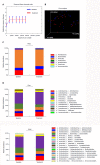Rifaximin ameliorates hepatic encephalopathy and endotoxemia without affecting the gut microbiome diversity
- PMID: 29307995
- PMCID: PMC5743506
- DOI: 10.3748/wjg.v23.i47.8355
Rifaximin ameliorates hepatic encephalopathy and endotoxemia without affecting the gut microbiome diversity
Abstract
Aim: To determine the efficacy of rifaximin for hepatic encephalopathy (HE) with the linkage of gut microbiome in decompensated cirrhotic patients.
Methods: Twenty patients (12 men and 8 women; median age, 66.8 years; range, 46-81 years) with decompensated cirrhosis (Child-pugh score > 7) underwent cognitive neuropsychological testing, endotoxin analysis, and fecal microbiome assessment at baseline and after 4 wk of treatment with rifaximin 400 mg thrice a day. HE was determined by serum ammonia level and number connection test (NCT)-A. Changes in whole blood endotoxin activity (EA) was analyzed by endotoxin activity assay. Fecal microbiome was assessed by 16S ribosome RNA (rRNA) gene sequencing.
Results: Treatment with rifaximin for 4 wk improved hyperammonemia (from 90.6 ± 23.9 μg/dL to 73.1 ± 33.1 μg/dL; P < 0.05) and time required for NCT (from 68.2 ± 17.4 s to 54.9 ± 20.3 s; P < 0.05) in patients who had higher levels at baseline. Endotoxin activity was reduced (from 0.43 ± 0.03 to 0.32 ± 0.09; P < 0.05) in direct correlation with decrease in serum ammonia levels (r = 0.5886, P < 0.05). No statistically significant differences were observed in the diversity estimator (Shannon diversity index) and major components of the gut microbiome between the baseline and after treatment groups (3.948 ± 0.548 at baseline vs 3.980 ± 0.968 after treatment; P = 0.544), but the relative abundances of genus Veillonella and Streptococcus were lowered.
Conclusion: Rifaximin significantly improved cognition and reduced endotoxin activity without significantly affecting the composition of the gut microbiome in patients with decompensated cirrhosis.
Keywords: Endotoxin; Gut microbiome; Hepatic encephalopathy; Liver cirrhosis; Rifaximin.
Conflict of interest statement
Conflict-of-interest statement: The authors declare that there is no conflict of interest regarding the publication of this paper.
Figures






References
-
- Prakash R, Mullen KD. Mechanisms, diagnosis and management of hepatic encephalopathy. Nat Rev Gastroenterol Hepatol. 2010;7:515–525. - PubMed
-
- Rikkers L, Jenko P, Rudman D, Freides D. Subclinical hepatic encephalopathy: detection, prevalence, and relationship to nitrogen metabolism. Gastroenterology. 1978;75:462–469. - PubMed
-
- Ortiz M, Jacas C, Córdoba J. Minimal hepatic encephalopathy: diagnosis, clinical significance and recommendations. J Hepatol. 2005;42 Suppl:S45–S53. - PubMed
-
- Chen Y, Yang F, Lu H, Wang B, Chen Y, Lei D, Wang Y, Zhu B, Li L. Characterization of fecal microbial communities in patients with liver cirrhosis. Hepatology. 2011;54:562–572. - PubMed
MeSH terms
Substances
LinkOut - more resources
Full Text Sources
Other Literature Sources
Medical

